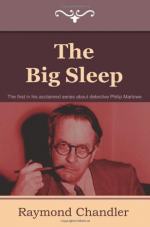|
This section contains 383 words (approx. 1 page at 400 words per page) |

|
Dialogue
Dialogue, the conversation between two or more characters, is a primary tool writers use for characterization and to drive plots. Writers use dialogue to reveal the desires, motivations, and character of the players in their stories, helping to create an idea and an image of them in readers' minds. Chandler is known as a master of vernacular dialogue. His characters talk the way that 1930s thugs, cops, and private investigators talk on the job, in language studded with slang such as "loogan" (a man with a gun), "peeper" (private investigator), and "centuries" (hundred dollar bills). His characters, especially Marlowe, are also known for their use of biting similes to describe someone or thing. Similes are comparisons that employ "as" or "like." For example, in describing the way Brody's cigarette dangles from his mouth, Marlowe states: "His cigarette was jiggling like a doll on a coiled spring." This is...
|
This section contains 383 words (approx. 1 page at 400 words per page) |

|




